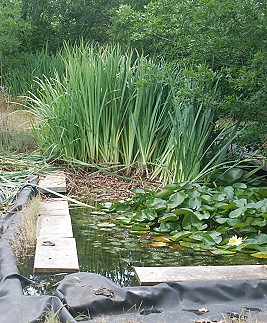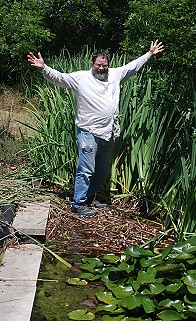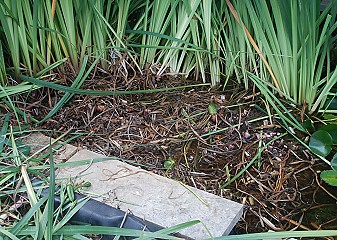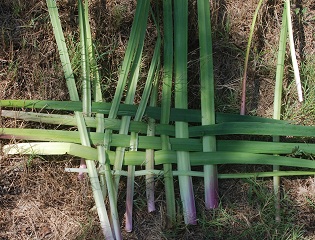Because there’s no permanent natural water on our place, the main aquatic habitat we can provide for wildlife is near the house (where, if we don’t collect enough rainwater, we can use city water–in fact, the water garden began with city water supply.) It has an upper, stream-like section (small pools with low “falls” into each other, all in the shade) and a bottom pool that’s a 10×20 foot lily pond–with wide shallow ledges around the edge and a deep “trench” in the middle for the lilies.
To provide some vertical plantlife for dragonflies, damselflies, and other insects that need emergent vegetation, we added in pickerelweed and water iris. The water iris turned out to be very aggressive. Periodically we have to cut it back, and that’s a huge chore.

The irises were both shading and crowding out the water lilies, taking up more than half the pond surface…in the picture above, Richard has started cutting them off at water level. The mat was dense enough for him to stand it’s supported below by the wide shallow ledge one foot down.

We don’t want to get rid of the irises completely in the lower pond–the dragonflies love to sit on the leaves; the spreadwing damsels oviposit in the stems, and the mass of roots below the water line is a fine habitat for tadpoles and odonate larvae. But we also like the waterlilies. We used to have three colors (white, yellow, pink) and we think the irises completely choked off the white ones (they were on the iris end of the group.)

And when the root-mat gets this thick, it’s attractive to more than the little critters we want–we don’t mind the occasional red-lined-ribbon snake, even if it does eat some of what the pond’s intended to grow, but the larger water snakes that move in when the irises fill up the place clean out the whole frog population for awhile–and that’s not good.
The long leaves cut from the irises gave me ideas–they ought to be good for something–and this morning I tried a simple weave of the full-width leaves (and by the way, I love the delicate purple at the bottom of the leave-bundle!):
 I thought, being flat, they’d be more flexible, but they do “crack” somewhat. I’m not sure if they need to be pressed flat, or perhaps slit into narrower sections and dried, or what. This was only a first dry–I just feel that such lovely long leaves should be useful…they’re nearly waterproof, for instance, as the beads of water from last night’s storm showed.
I thought, being flat, they’d be more flexible, but they do “crack” somewhat. I’m not sure if they need to be pressed flat, or perhaps slit into narrower sections and dried, or what. This was only a first dry–I just feel that such lovely long leaves should be useful…they’re nearly waterproof, for instance, as the beads of water from last night’s storm showed.
Getting the root-mat out will be difficult. The rhizomes are thick and hard (a chain saw cuts them, and so does an axe, but the pool has a liner which cuts a lot easier.) And they’re *heavy*. If we can get a stout plank between the liner on the shelf and the root mat, then we could use the brute-force method of cutting up the rhizomes and haul them out one by one.
We need to get them back to 1/4 or less of the lily pond area, which will open up better habitat for the lily-loving species.
[Edited in the afternoon to add picture of Richard on the root mat.]
Comment by Abigail M — June 12, 2009 @ 2:37 pm
I have a stock-pond into which I several times tried to plant water-lilies, which each time immediately disappeared.
When I became active with the Master Naturalists and did a workshop on restoring water vegetation to ponds, I learned why. We planted each of our water lilies, lotus, pickerelweed, etc. inside an anchored ring of 2″ mesh fencewire. The young plants filled up the ring to within about 2″ of the wire — the distance a turtle could stick its neck through the wire to munch on the salad. Only when they had filled up their 5-foot rings were the plants judged sturdy enough to be freed to spread in the pond and fight it out with the turtles. Some disappeared, some spread. The lotus did so well that we had to go after it like you with your iris.
Comment by elizabeth — June 12, 2009 @ 3:04 pm
We had a turtle briefly last fall–a nice red-eared slider. How it found us when we were surrounded by acres and acres and acres of dry, I don’t know–could a turtle possibly smell water over a quarter mile if it had come up the dry creek bed hoping for better? Anyway, I thought “Oh, good, it will munch on the iris. Or even the water lilies (which are also somewhat overgrown.) But I didn’t see much if any sign that it was reducing the vegetation. But our water garden is really too small to support a turtle population and they all seem to recognize that and move on. We’ve had a red-eared briefly twice, and a mud turtle briefly (and early on) once.
Comment by elizabeth — June 12, 2009 @ 3:07 pm
Oh–I added a picture of Richard standing on the root mat, for anyone who wandered by earlier and might want to see it.
Comment by green_knight — June 13, 2009 @ 1:38 am
Think they’ll be useful as thatch?
Please, please, PLEASE tell me they’d be useful as thatch, at least as a temporary solution. This will fill a massive, massive plothole in a book where people need to cut _something_ for thatch in spring/early summer, and then I started reading up about reeds and sobbed in despair.
Comment by elizabeth — June 13, 2009 @ 8:15 am
I don’t know. I don’t know enough about thatch in its various forms. (Where I grew up, palm fronds could be used as thatch. That’s the thatch I know best.) The longest leaves of our water iris are 3-4 feet long individually. If you cut the whole plant off at the water line, you get some plants that are more like 5 feet long, but what was the top is several leaves splayed apart. Given the water-proofness of the leaves, maybe you could bundle plants together to make the “bundles” of thatch and then bind them to a roof structure…but how they’d work when dried up, I don’t know. I’m testing the “mat” by leaving it out in the sun a few days.
E.
Comment by green_knight — June 13, 2009 @ 3:41 pm
I’m testing the “mat” by leaving it out in the sun a few days.
I will be eternally grateful. It doesn’t have to be a long-term solution, just until they can get the proper thing (though it would be even better if it *were* a workable solution. From the ‘horrors of research’ file: you have your characters do something and find that it’s impossible to *do* that at the time of year the story is set.
On the other hand, I was eyeing my rhubarb and wondering whether *that* would work – the leaves just don’t seem to compost, and my, aren’t they ever big…
Comment by elizabeth — June 13, 2009 @ 5:28 pm
Beyond this reply, can we move the discussion of writing-related stuff to my LJ or even the Paksworld blog? I posted on “lost crafts” in LJ and it would fit better there…
But I’d bet desperate people would try anything (Gird certainly did.) I know that in other climes than this, banana and palm leaves (and I think I’ve read of other broad, large leaves) have been used as thatch.
I have a possible writer-fix I’ll be glad to post somewhere else, but this blog isn’t really about that craft.